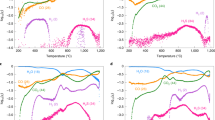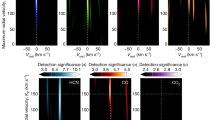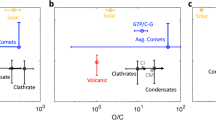Abstract
Almost a decade after methane was first reported in the atmosphere of Mars1,2 there is an intensive discussion about both the reliability of the observations3,4—particularly the suggested seasonal and latitudinal variations5,6—and the sources of methane on Mars. Given that the lifetime of methane in the Martian atmosphere is limited1,6, a process on or below the planet’s surface would need to be continuously producing methane. A biological source would provide support for the potential existence of life on Mars, whereas a chemical origin would imply that there are unexpected geological processes7. Methane release from carbonaceous meteorites associated with ablation during atmospheric entry is considered negligible8. Here we show that methane is produced in much larger quantities from the Murchison meteorite (a type CM2 carbonaceous chondrite) when exposed to ultraviolet radiation under conditions similar to those expected at the Martian surface. Meteorites containing several per cent of intact organic matter reach the Martian surface at high rates9, and our experiments suggest that a significant fraction of the organic matter accessible to ultraviolet radiation is converted to methane. Ultraviolet-radiation-induced methane formation from meteorites could explain a substantial fraction of the most recently estimated atmospheric methane mixing ratios3,4. Stable hydrogen isotope analysis unambiguously confirms that the methane released from Murchison is of extraterrestrial origin. The stable carbon isotope composition, in contrast, is similar to that of terrestrial microbial origin; hence, measurements of this signature in future Mars missions may not enable an unambiguous identification of biogenic methane.
This is a preview of subscription content, access via your institution
Access options
Subscribe to this journal
Receive 51 print issues and online access
$199.00 per year
only $3.90 per issue
Buy this article
- Purchase on Springer Link
- Instant access to full article PDF
Prices may be subject to local taxes which are calculated during checkout



Similar content being viewed by others
References
Krasnopolsky, V. A., Maillard, J. P. & Owen, T. C. Detection of methane in the Martian atmosphere: evidence for life? Icarus 172, 537–547 (2004)
Formisano, V., Atreya, S., Encrenaz, T., Ignatiev, N. & Giuranna, M. Detection of methane in the atmosphere of Mars. Science 306, 1758–1761 (2004)
Zahnle, K., Freedman, R. S. & Catling, D. C. Is there methane on Mars? Icarus 212, 493–503 (2011)
Krasnopolsky, V. A. Search for methane and upper limits to ethane and SO2 on Mars. Icarus 217, 144–152 (2012)
Mumma, M. J. et al. Strong release of methane on Mars in northern summer 2003. Science 323, 1041–1045 (2009)
Lefèvre, F. & Forget, F. Observed variations of methane on Mars unexplained by known atmospheric chemistry and physics. Nature 460, 720–723 (2009)
Etiope, G., Oehler, D. Z. & Allen, C. C. Methane emissions from Earth's degassing: implications for Mars. Planet. Space Sci. 59, 182–195 (2011)
Court, R. W. & Sephton, M. A. Investigating the contribution of methane produced by ablating micrometeorites to the atmosphere of Mars. Earth Planet. Sci. Lett. 288, 382–385 (2009)
Flynn, G. J. & McKay, D. S. An assessment of the meteoritic contribution to the Martian soil. J. Geophys. Res. B 95, 14497–14509 (1990)
Geminale, A., Formisano, V. & Sindoni, G. Mapping methane in Martian atmosphere with PFS-MEX data. Planet. Space Sci. 59, 137–148 (2011)
Shkrob, I. A., Chemerisov, S. D. & Marin, T. W. Photocatalytic decomposition of carboxylated molecules on light-exposed Martian regolith and its relation to methane production on Mars. Astrobiology 10, 425–436 (2010)
Schuerger, A. C., Clausen, C. & Britt, D. Methane evolution from UV-irradiated spacecraft materials under simulated Martian conditions: implications for the Mars Science Laboratory (MSL) mission. Icarus 213, 393–403 (2011)
Atreya, S. K., Mahaffy, P. R. & Wong, A. S. Methane and related trace species on Mars: origin, loss, implications for life, and habitability. Planet. Space Sci. 55, 358–369 (2007)
Vigano, I. et al. Effect of UV radiation and temperature on the emission of methane from plant biomass and structural components. Biogeosciences 5, 937–947 (2008)
McLeod, A. R. et al. Ultraviolet radiation drives methane emissions from terrestrial plant pectins. New Phytol. 180, 124–132 (2008)
Cockell, C. S. et al. The ultraviolet environment of Mars: biological implications past, present, and future. Icarus 146, 343–359 (2000)
ten Kate, I. L. et al. Amino acid photostability on the Martian surface. Meteorit. Planet. Sci. 40, 1185–1193 (2005)
Stoker, C. R. & Bullock, M. A. Organic degradation under simulated Martian conditions. J. Geophys. Res. E 102, 10881–10888 (1997)
Chun, S. F. S., Pang, K. D., Cutts, J. A. & Ajello, J. M. Photocatalytic oxidation of organic compounds on Mars. Nature 274, 875–876 (1978)
Flynn, G. J. The delivery of organic matter from asteroids and comets to the early surface of Mars. Earth Moon Planets 72, 469–474 (1996)
Wong, N. et al. in Proceedings of the Twelfth ASCE Aerospace Division International Conference on Engineering, Science, Construction, and Operations in Challenging Environments and the Fourth NASA/ARO/ASCE Workshop on Granular Materials in Lunar and Martian Exploration (eds Song, G. & Malla, R.B. ) 29–35 (ASCE, 2010)
Butterworth, A. L., Aballain, O., Chappellaz, J. & Sephton, M. A. Combined element (H and C) stable isotope ratios of methane in carbonaceous chondrites. Mon. Not. R. Astron. Soc. 347, 807–812 (2004)
Bartoszek, M., Wecks, M., Jakobs, G. & Mohlmann, D. Photochemically induced formation of Mars relevant oxygenates and methane from carbon dioxide and water. Planet. Space Sci. 59, 259–263 (2011)
Allen, C. C., Gooding, J. L., Jercinovic, M. & Keil, K. Altered basaltic glass — a terrestrial analog to the soil of Mars. Icarus 45, 347–369 (1981)
Kieffer, H. H. et al. Thermal and albedo mapping of Mars during the Viking Primary Mission. J. Geophys. Res. 82, 4249–4291 (1977)
Robert, F. & Epstein, S. The concentration and isotopic composition of hydrogen, carbon and nitrogen in carbonaceous meteorites. Geochim. Cosmochim. Acta 46, 81–95 (1982)
Sephton, M. A. et al. Investigating the variations in carbon and nitrogen isotopes in carbonaceous chondrites. Geochim. Cosmochim. Acta 67, 2093–2108 (2003)
Sephton, M. A. Organic compounds in carbonaceous meteorites. Nat. Prod. Rep. 19, 292–311 (2002)
Vigano, I. et al. The stable isotope signature of methane emitted from plant material under UV irradiation. Atmos. Environ. 43, 5637–5646 (2009)
ten Kate, I. L. Organics on Mars? Astrobiology 10, 589–603 (2010)
Navarro-González, R., Vargas, E., de la Rosa, J., Raga, A. C. & McKay, C. P. Reanalysis of the Viking results suggests perchlorate and organics at midlatitudes on Mars. J. Geophys. Res. E 115, 12010, http://dx.doi.org/10.1029/2010JE003599 (2010)
Hecht, M. H. et al. Detection of perchlorate and the soluble chemistry of Martian soil at the Phoenix Lander site. Science 325, 64–67 (2009)
Clark, B. C. & Baird, A. K. Is the Martian lithosphere sulfur rich? J. Geophys. Res. 84, 8395–8403 (1979)
Acknowledgements
F.K. was supported by the ESF (EURYI award to F.K.) and DFG (KE 884/2-1). Measurements at Utrecht University were funded by the Dutch NWO (grant number 865.07.001). A.M. was supported by the NERC (NE/F020422/1) and a Royal Society Leverhulme Trust senior research fellowship. We thank M. Greule, F. Althoff, A. Jugold, C. Tubbesing and H. F. Schöler for technical support; H. van Weelden from the Utrecht Medical Center for measuring the spectral distribution of the Xe lamp and calibrating the Waldmann ultraviolet meter; C. Brenninkmeijer, J. Lelieveld and C. Cockell for advice; and C. Jäger for providing data on ultraviolet absorption by minerals.
Author information
Authors and Affiliations
Contributions
F.K., I.V., A.M. and T.R. planned the study. I.V., F.K. and M.F. carried out the experiments. F.K., I.V., A.M., U.O. and T.R. worked on the scientific interpretation and wrote the manuscript.
Corresponding author
Ethics declarations
Competing interests
The authors declare no competing financial interests.
Supplementary information
Supplementary Information
This file contains Supplementary Text, Supplementary Figures 1-9, Supplementary Table 1 and Supplementary References. (PDF 709 kb)
Rights and permissions
About this article
Cite this article
Keppler, F., Vigano, I., McLeod, A. et al. Ultraviolet-radiation-induced methane emissions from meteorites and the Martian atmosphere. Nature 486, 93–96 (2012). https://doi.org/10.1038/nature11203
Received:
Accepted:
Published:
Issue Date:
DOI: https://doi.org/10.1038/nature11203
This article is cited by
-
Transcriptional response to prolonged perchlorate exposure in the methanogen Methanosarcina barkeri and implications for Martian habitability
Scientific Reports (2021)
-
Independent confirmation of a methane spike on Mars and a source region east of Gale Crater
Nature Geoscience (2019)
-
Aeolian abrasion of rocks as a mechanism to produce methane in the Martian atmosphere
Scientific Reports (2019)
-
Impacts of Cosmic Dust on Planetary Atmospheres and Surfaces
Space Science Reviews (2018)
-
Astrobiology and the Possibility of Life on Earth and Elsewhere…
Space Science Reviews (2017)
Comments
By submitting a comment you agree to abide by our Terms and Community Guidelines. If you find something abusive or that does not comply with our terms or guidelines please flag it as inappropriate.



